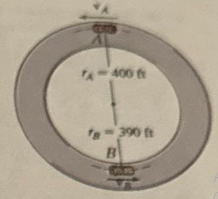5. Two cars are traveling around a circular track as shown below. Answer the following questions. a. Use the drawing provided to clearly indicate the origin and direction of , and f, for each car. b. If both cars are traveling at the same speed, which car has a greater normal acceleration? Justify your response in words. c. If both cars travel at 50 mph, what is their velocity in ft/s? Show your work. 7A-400 ft fa- 390 ft B
5. Two cars are traveling around a circular track as shown below. Answer the following questions. a. Use the drawing provided to clearly indicate the origin and direction of , and f, for each car. b. If both cars are traveling at the same speed, which car has a greater normal acceleration? Justify your response in words. c. If both cars travel at 50 mph, what is their velocity in ft/s? Show your work. 7A-400 ft fa- 390 ft B
Elements Of Electromagnetics
7th Edition
ISBN:9780190698614
Author:Sadiku, Matthew N. O.
Publisher:Sadiku, Matthew N. O.
ChapterMA: Math Assessment
Section: Chapter Questions
Problem 1.1MA
Related questions
Question

Transcribed Image Text:5. Two cars are traveling around a circular track as shown below. Answer the following questions.
a.
Use the drawing provided to clearly indicate the origin and direction
of û, and ûn for each car.
a.
b. If both cars are traveling at the same speed, which car has a greater
normal acceleration? Justify your response in words.
C.
If both cars travel at 50 mph, what is their velocity in ft/s? Show your work.
Magnitude rounded to 3 sig. fig.
Magnitude rounded to 3 sig. fig.
Units
6. At the instant shown below, the bucket of the backhoe traces a path defined by r = 25 sin 0 ft, where 8 is
in radians. When the bucket is at 0 = 100°, its angular velocity is 1.8 rad/s and its angular
acceleration is Ö = -0.4 rad/s2. Answer the following questions.
What is the radius, r, at this instant? Show your work.
Magnitude rounded to 3 sig. fig.
Units
b. What is ve at this instant? Show your work.
Units
7-400 ft
=
fe= 390 ft
B
Expert Solution
Step 1 Given
“Since you have posted multiple questions, we will provide the solution only to the first question as per our Q&A guidelines. Please repost the remaining questions separately.”

Trending now
This is a popular solution!
Step by step
Solved in 3 steps with 2 images

Knowledge Booster
Learn more about
Need a deep-dive on the concept behind this application? Look no further. Learn more about this topic, mechanical-engineering and related others by exploring similar questions and additional content below.Recommended textbooks for you

Elements Of Electromagnetics
Mechanical Engineering
ISBN:
9780190698614
Author:
Sadiku, Matthew N. O.
Publisher:
Oxford University Press

Mechanics of Materials (10th Edition)
Mechanical Engineering
ISBN:
9780134319650
Author:
Russell C. Hibbeler
Publisher:
PEARSON

Thermodynamics: An Engineering Approach
Mechanical Engineering
ISBN:
9781259822674
Author:
Yunus A. Cengel Dr., Michael A. Boles
Publisher:
McGraw-Hill Education

Elements Of Electromagnetics
Mechanical Engineering
ISBN:
9780190698614
Author:
Sadiku, Matthew N. O.
Publisher:
Oxford University Press

Mechanics of Materials (10th Edition)
Mechanical Engineering
ISBN:
9780134319650
Author:
Russell C. Hibbeler
Publisher:
PEARSON

Thermodynamics: An Engineering Approach
Mechanical Engineering
ISBN:
9781259822674
Author:
Yunus A. Cengel Dr., Michael A. Boles
Publisher:
McGraw-Hill Education

Control Systems Engineering
Mechanical Engineering
ISBN:
9781118170519
Author:
Norman S. Nise
Publisher:
WILEY

Mechanics of Materials (MindTap Course List)
Mechanical Engineering
ISBN:
9781337093347
Author:
Barry J. Goodno, James M. Gere
Publisher:
Cengage Learning

Engineering Mechanics: Statics
Mechanical Engineering
ISBN:
9781118807330
Author:
James L. Meriam, L. G. Kraige, J. N. Bolton
Publisher:
WILEY